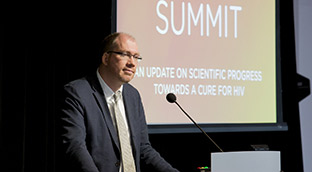Predicting Changes in the HIV Reservoir
Researchers zero in on a marker that might be able to target persistence, the main barrier to a cure
By Jeffrey Laurence, M.D.

Research question
Reservoirs maintaining latent HIV persist in people living with HIV (PLWH) even if they are taking antiretroviral therapy (ART). If ART is stopped, latent HIV that is intact activates and the virus rebounds.
But scientists have also discovered that the reservoir decays. It’s a very slow process though it may be sped up depending on individual biological variability, timing of ART initiation, and/or therapeutic agents.
The current gold standard of measuring changes in reservoir size is to quantify inducible, fully active latent HIV, but that is resource-intensive and requires large amounts of blood, and is thus not feasible for most clinical studies. Genetic techniques are easier and can more accurately define numbers of intact vs. defective latent viruses. What scientists lack is an efficient method to precisely predict changes in this reservoir over time, a critical priority in HIV cure research.
Findings
Seventy-four predominantly male PLWH were identified from the San Francisco SCOPE study. Participants had undetectable virus for at least two years.
The researchers hypothesized that changes in plasma levels of inflammatory factors might best serve to identify changes in the intact HIV reservoir over time. Indeed, of the 32 factors analyzed, one stood out: Galectin-9.
Lower Gal-9 levels predicted faster decay of the intact HIV reservoir, with a tenfold decrease in Gal-9 correlating with a 45% greater annual diminution of the reservoir.
But more importantly than simply establishing a marker, an intriguing point here is that Gal-9 itself might control this reservoir reduction. Gal-9 is a sugar-protein that regulates immune and cell stress pathways and cancer cell survival, and it can activate HIV as well as enhance anti-HIV defenses.
Impact
The authors conclude that “[t]he results support exploring Gal-9 modulation to target HIV persistence. Additionally, the findings suggest that individuals with lower Gal-9 levels might respond better to strategies aimed at reducing reservoir levels,” a key part of an HIV cure.
amfAR’s role
amfAR was a funder of this research. amfAR grantee Dr. Timothy Henrich, of Zuckerberg San Francisco General Hospital and the University of California, San Francisco, is a co-author of the study.
Original article
http://www.ncbi.nlm.nih.gov/pubmed/39207259
Dr. Laurence is amfAR’s senior scientific consultant.
Share This:
